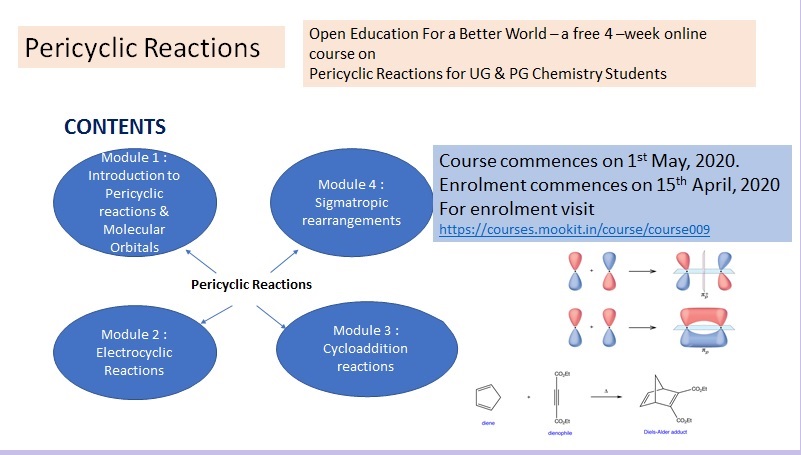Pericyclic Reactions
Course Description
Pericyclic reactions are an important class of organic reactions which are very useful in organic synthesis. They are highly stereoselective and useful in C-C bond formation reactions as well as in synthesis of heterocyclic compounds.
This course aims at explaining the different types of pericyclic reactions, the stereochemistry of the same and simple rules to predict the feasibility of the reaction and the stereochemical outcome. The concepts will be explained in simple, lucid language using several examples and extensive problem solving.
Course Content
Module 1 :Introduction to Pericyclic reactions & Molecular Orbitals
1.1 Introduction
1.2 What is a pericyclic reaction?
1.3 Classification of a pericyclic reaction
1.3.1 Electrocyclic reaction
1.3.2 Cycloaddition reactions
1.3.3 Sigmatropic rearrangements
1.3.4 Cheletropic reactions
1.3.5 Group transfer or ene reactions
1.4 MOs and their importance in pericyclic reactions
1.4.1 Drawing MOs for ethylene, butadiene , hexatriene, allylic systems
Module 2:: Electrocyclic reactions
2.1 Introduction; electrocyclic ring closing and ring opening reactions
2.2 Symmetry elements mirror plane (σ) and C2 axis
2.3 HOMO & LUMO and their symmetry w.r.t mirror plane (σ) and C2 axis in ethylene, butadiene, hexatriene, allylic systems
2.4 Conrotatory and disrotatory motions of ring closing and ring opening reactions in butadiene and hexatriene systems.
2.5 Stereochemical outcome of electrocyclic ring closing in butadiene and hexatriene systems
2.6 Woodward Hoffman rules for electrocyclic reactions
Module 3: Cycloaddition reactions
3.1 Introduction to cycloaddition reactions
3.2 [4+2] cycloaddition
3.2.1 FMOs in [4+2] cycloaddition
3.2.2 Supra facial and antrafacial modes of cycloaddition
3.2.3 Regioselectivity in [4+2] cycloadditions
3.2.4 Stereoselectivity in [4+2] cycloaddition ; endo/exo selectivity
3.3 [2+2] cycloaddition
3.3.1 FMOs in [2+2] cycloaddition
3.3.2 Regio – and stereoselectivity in [2+2] cycloadditions
3.3.3[ 2+2] cycloaddition involving ketenes
3.4 Intramolecular cycloaddition reactions
3.5 1,3 dipolar cycloaddition
3.6 Cheletropic reactions
Module 4: Sigmatropic reactions
4.1 Introduction to sigmatropic rearrangements and classification as [i,j]
4.2[ 1,j] sigmatropic shifts involving migration of H & D
4.3 FMOs in sigmatropic migration ;Supra and Antrafacial migrations
4.4 [3,3]sigmatropic shifts: the Cope and Claisen rearrangement
4.5 Applications of pericyclic reactions
Course Audience
Third year students of B.Sc , M.Sc -Ist year and 2nd year Chemistry students and teachers
Outcomes of this Course
At the end of the course students will be able to
- Identify a pericyclic reaction.
- Distinguish between a polar/non polar and pericyclic reaction.
- Classify a pericyclic reaction
- Count the number of electrons involved in a pericyclic reaction
- Explain the importance of MO’s in pericyclic reactions
- Draw the MOs for polyenes
- Identify the FMO’s (HOMO & LUMO) participating in the pericyclic reaction
- Assign the symmetry element associated with the HOMO and LUMO
- Predict whether the pericyclic reaction will proceed under thermal or photochemical conditions
- Infer the stereochemical outcome of a pericyclic reaction
- Write the products of a given pericyclic reaction with the correct stereochemistry
- Deduce the allowedness of a pericyclic reaction using the Woodward Hoffman rules.
Copyright 2015· All rights reserved
Designed by Zymphonies

